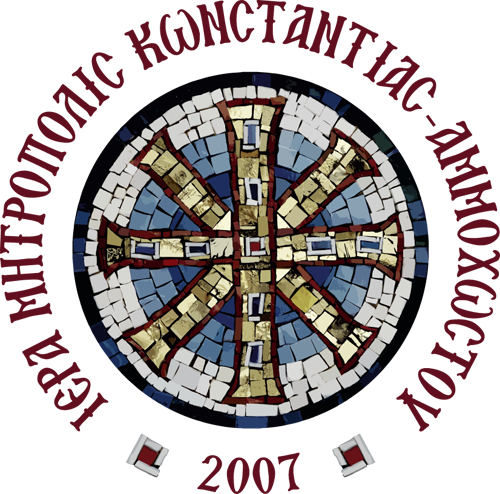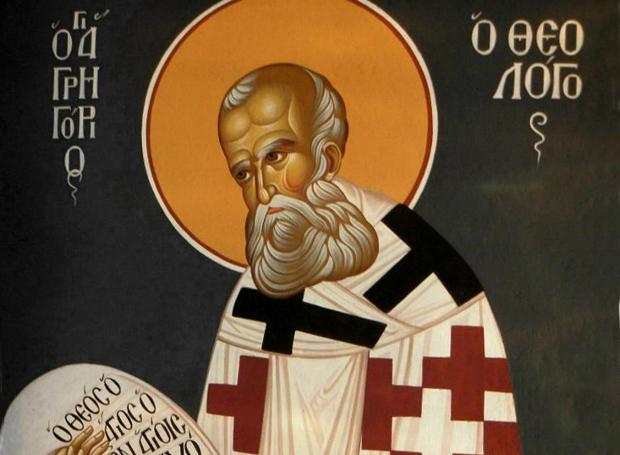The Life of Saint Gregory – Commemorated on 25 January
St. Gregory the Theologian, was one of the four great doctors of the Church during the 4th century AD, along with Saints Basil the Great, John Chrysostom and Athanasios the Great. He is also remembered as one of the three so-called Cappadocian Fathers, an honour he shares with Sts Basil and Gregory of Nyssa. He is also recognized as the champion of Orthodoxy against the heretical doctrine of Arianism. Saint Gregory is also commonly referred to as Gregory of Nazianzus.
Gregory was born in Arianzos, near Nazianzus in Southwestern Cappadocia, Asia Minor. He was born in 329 or 330 AD. Saint Gregory’s parents were wealthy, honorable and virtuous. His mother, Nonna was a pious Orthodox Christian. His father, Gregory, was an idolater who converted to Orthodoxy and was ordained to the priesthood in 330. He served in Nazianzus. Saint Gregory had one sister, Gorgonia and a brother Caesarios. Caesarios became a physician.
Before his birth, Nonna consecrated Gregory to God, and she was given a holy vision that told her prayer would be answered and what her son would be named. She was also told that he would become a genuine slave to God. In his writings, Saint Gregory recounts an episode from his childhood when she took him in her arms and uttered the following words: “This beloved child, the gift of God, soon to become a sacred victim, is a precious charge under escort to the altar. He is the offspring of Sarah, late in motherhood. He is the root of the race, the produce of hope and the divine promise…Accordingly, in fulfillment of my promise, I offer thee a living victim unto God.”
Saint Gregory attended school in Nazianzus and later went to Caesaria where he met St. Basil the Great. He then studied at the Catechetal School in Alexandria. This allowed him to be close to his brother who was attending medical school in Alexandria. At age 20, he became dissatisfied with life in Egypt and decided to go to Athens. He left for Greece in November when the seas are often rough. When they were in sight of Crete, the ship was hit by a tremendous tempest. The ship became waterlogged and all feared death. For 20 days, St. Gregory lay prostrate in the ship, praying to the Almighty for mercy. What Gregory feared the most was the fate of his soul, as he had not yet been Baptized. He gave himself to God in a sacred promise.
In Athens, he renewed his friendship with Basil. Their friendship deepened due to their common love of philosophy and contemplative life. At the suggestion of Basil, the two friends became monastics at a retreat in Pontos, where each embarked on a spiritual journey that was to lead them both to greatness. It is unknown if Gregory was baptized at school or when he was in Pontos, however, he was baptized sometime before 360 when he returned home to Nazianzus. Gregory felt a responsibility and obligation to his aging parents and, with some degree of reluctance was ordained into the priesthood to serve as an assistant to his father, the bishop of Nazianzos. The son’s brilliance as a preacher outshone his father’s. When barely thirty years old, he won acclaim throughout the region as a mighty warrior in the fight against paganism and heresy. Over the next ten years, he spent his time aiding his father and living intermittently the monastic life with Basil at Pontus. During this time, the two compiled a memorable book of extracts, which they published in 27 books. They called it the Philokalia, which was an invaluable aid to the faithful and scholars.
It was largely through the influence of Gregory and his father that his friend Basil was made bishop of Caesaria in 370. In 371, Emperor Valens divided the providence of Cappodocia into two administrators.
Basil opposed the division of his diocese, however, Anthimos, proclaimed himself to be the metropolitan of the newly formed province. Basil appointed Gregory as bishop of the relatively unimportant town of Sasima, a post he never sought, and in which he never served. Anthimos occupied the village with troops, thus thwarting Gregory from taking peaceful succession of his see. Hewrote: “I have not touched at all the church allotted to me, even to the extent of having offered a single sacrifice there, or leading the congregation in prayer or ordaining a single cleric.”
Gregory remained with his father in Nazianzos. He took over the church of Nazianzos after the death of his father in 374 and remained there for one year waiting the appointment of a legitimate successor. With the loss of his father, he had a longing to return to asceticism in some retreat, there to meditate, pray, and interpret the Scriptures.
Gregory became ill in 375 and was allowed to go to the seclusion of Seleucia in Isauria. He lived there for three to four years. Saint Basil implored him to return from seclusion and he did. He then began working in the poor houses and hospitals, many of which were built by St. Basil.
After the death of the Arian Emperor Valens, followed closely by the death of Gregory’s friend Basil, Gregory was called to Constantinople.
He was to head the reorganization of the Orthodox Church which had been torn asunder by the heresy of Arianism from within and by the harassment of pagans without. In the course of this holy work, he achieved distinction as an orator, traditionalist, and a crusader that earned him the title of “Theologian” despite the opposition of Maximos the Cynic, who had been set up against him by the bishop of Alexandria. St. Gregory admitted that, “the ignorance I displayed with regard to Maximos deserves censure…For a trusting person is the easiest in the world to persuade, since he is impulsively drawn to goodness, real or counterfeit.”
The Orthodox Emperor Theodosios came to power in 380 AD and transferred the Church of the Holy Apostles to Bishop Gregory.
Gregory assumed the direction of the magnificent Church of Ayia Sophia, the most prestigious house of God in all Christendom. While director of this mighty church, Gregory took part in a synod held in Constantinople in 381AD to settle the differences among the prelates of the Church. Known as the Second Ecumenical Synod, it resolved the issues and voted to accept Gregory as patriarch of Constantinople. It further added its official support to the Nicene doctrine which was championed at the First Synod in Nicaea.
For as long as he held the post of spiritual leader of Orthodoxy the gallant Gregory served with honour and dignity. Moreover, he was the instrument of God in unifying the Church into a cohesive unit that could withstand any internal or external pressure. He grew weary of the personal attacks that are the occupational hazard of a patriarch and after a moving farewell address, he retired to live out his days in meditation, writing, and prayer.
From 381 and henceforth, he lived in retirement at his paternal home, though at a distance he maintained his care for his native church in Nazianzus. He continued his austere asceticism, contemplation and literary pursuits. St. Gregory was a poet and a man of letters.
Many of his epistles and poems were written during this period. He still participated in Church affairs through the operation of his numerous epistles. He maintained a sincere and active interest in the welfare and sufferings of others around him.
In his seclusion, St. Gregory was rigorous in his self-denial and his only indulgences were a garden and a fountain. His knees were worn from prostrations in prayer. he longed to depart and be with Christ.
He kept a bed of straw covered with a sackcloth. He donned only a single rough tunic and went about without shoes. He was active and alert till the end. At sixty-two years of age, he reposed on January 25, 391. He is described as having a graceful, charming and even playful manner. His manner was simple, friendly and attractive. His faith was zealous and fiery. His asceticism, used as a means of elevating and liberating the mind, was excessive, whereby he strained, if not injured, his health. He was a man of many talents and cultivation, with noble affections and deep feelings. He relics are kept at the Holy Monastery of Vatopedi on Mount Athos.
The Above information is From “Orthodox Saints” Vol 1 by Fr George Poulos, Holy Cross Orthodox Press; and The Lives of the Three Great Hierarchs: Basil the Great, Gregory the Theologian and John Chrysostom, Holy Apostles Convent.

